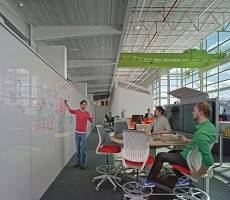October 17, 2014
Firms downsizing property dramatically as agile working takes hold, claims new report
 The sharp reduction in the amount of office space used by corporate occupiers as they adopt more agile working practices has been confirmed in a new study from facilities management services provider MITIE. The survey, as reported in the British Institute of Facilities Management (BIFM) magazine FM World, found that between the years of 2008 and 2014 firms reduced their floorspace by an average of 45 percent. The results of the report, based on interviews with property directors, mirror those of the Occupier Density Survey published last year by the British Council for Offices (BCO) which also found a marked (if smaller) reduction. The authors of the MITIE report conclude, similarly, that the economic downturn has been the main catalyst for the reduction in property used by occupiers and that the main way firms have accommodated the fall is with the uptake of flexible working practices.
The sharp reduction in the amount of office space used by corporate occupiers as they adopt more agile working practices has been confirmed in a new study from facilities management services provider MITIE. The survey, as reported in the British Institute of Facilities Management (BIFM) magazine FM World, found that between the years of 2008 and 2014 firms reduced their floorspace by an average of 45 percent. The results of the report, based on interviews with property directors, mirror those of the Occupier Density Survey published last year by the British Council for Offices (BCO) which also found a marked (if smaller) reduction. The authors of the MITIE report conclude, similarly, that the economic downturn has been the main catalyst for the reduction in property used by occupiers and that the main way firms have accommodated the fall is with the uptake of flexible working practices.
























October 17, 2014
The solution to complex issues like green building is to become more sophisticated
by Paul Goodchild • Comment, Environment, Facilities management, Workplace design
More →